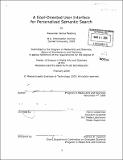A goal-oriented user interface for personalized semantic search
Author(s)
Faaborg, Alexander James
DownloadFull printable version (47.56Mb)
Other Contributors
Massachusetts Institute of Technology. Dept. of Architecture. Program In Media Arts and Sciences
Advisor
Henry Lieberman.
Terms of use
Metadata
Show full item recordAbstract
Users have high-level goals when they browse the Web or perform searches. However, the two primary user interfaces positioned between users and the Web, Web browsers and search engines, have very little interest in users' goals. Present-day Web browsers provide only a thin interface between users and the Web, and present-day search engines rely solely on keyword matching. This thesis leverages large knowledge bases of semantic information to provide users with a goal-oriented Web browsing experience. By understanding the meaning of Web pages and search queries, this thesis demonstrates how Web browsers and search engines can proactively suggest content and services to users that are both contextually relevant and personalized. This thesis presents (1) Creo, a Programming by Example system that allows users to teach their computers how to automate interactions with their favorite Web sites by providing a single demonstration, (2) Miro, a Data Detector that matches the content of a Web page to high-level user goals, and allows users to perform semantic searches, and (3) Adeo, an application that streamlines browsing the Web on mobile devices, allowing users to complete actions with a minimal amount of input and output. (cont.) An evaluation with 34 subjects found that they were more effective at completing tasks when using these applications, and that the subjects would use these applications if they had access to them. Beyond these three user interfaces, this thesis also explores a number of underlying issues, including (1) automatically providing semantics to unstructured text, (2) building robust applications on top of messy knowledge bases, (3) leveraging surrounding context to disambiguate concepts that have multiple meanings, and (4) learning new knowledge by reading the Web.
Description
Thesis (S.M.)--Massachusetts Institute of Technology, School of Architecture and Planning, Program in Media Arts and Sciences, February 2006. Includes bibliographical references (v. 2, leaves 280-288).
Date issued
2006Department
Program in Media Arts and Sciences (Massachusetts Institute of Technology)Publisher
Massachusetts Institute of Technology
Keywords
Architecture. Program In Media Arts and Sciences
